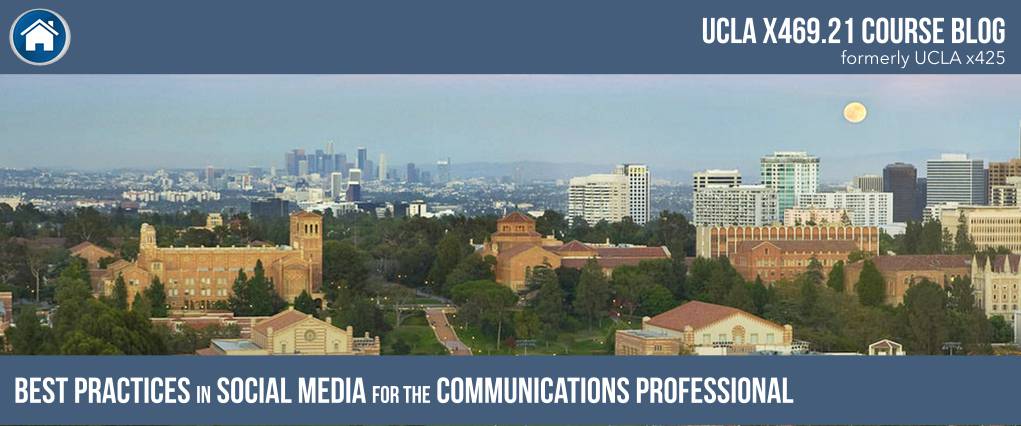
WEEK 2: A Conversation with Guest Speakers Babette Pepaj and Matt Meeks by Jessica Hammargren
By UCLA X469.21 Student Jessica Hammargren

Jessica Hammargren
Last Monday, our class had the opportunity to hear from Babette Pepaj and Matt Meeks as guest speakers. Babette is the founder of BakeSpace.com (the web’s first food social network), the Cookbook Café publishing platform and the TECHmunch food blogger conference, while Matt is chief digital and marketing officer for The LA Archdiocese (ADLA).
They both shared plenty of useful tips during the course of their discussion, and here are some of the highlights:

Babette Pepaj
Babette’s best practice tips:
• Traffic drivers – Babette shared her collaboration on “Chef” the movie as a sponsored campaign that generated significant online exposure for BakeSpace and the film. She created a cookbook for “Chef” with real recipes featured in the storyline. The cookbook was very successful, and even garnered earned media coverage in traditional newspapers because it made the movie relevant to readers interested in new recipes. Even today, three years later, she still advertises the “Chef” cookbook on Facebook and generates significant traffic.
• Preload content assets – One of Babette’s tips for making the most of her events and TECHmunch conferences on social media is to preload content assets (including photos and text) for the attendees to use on their blogs and social channels. She also encourages them to tag other attendees and influencers in their posts. She says doing so makes it hard for those individuals to ignore your content.
• Consistency – Babette stressed that consistency is essential to social media marketing. She advises to find the right platform that fits you the best; and “don’t force yourself to write a blog if you don’t like to write.”
• Live streaming – Babette encourages everyone to try Facebook Live and follow the latest developments involving the new Facebook Watch platform. She added that people get even more interested in video when it’s live – a phenomenon Babette observed first-hand when she created a live-streamed show called “Kitchen Party” that enabled viewers to ask questions live and subscribe through Facebook, YouTube and other social media sites.
Her best tip for attracting viewers to your live stream video on any topic is to feature an expert who can answer viewer questions. Another tip is to improvise, express your sense of humor and make it fun, even when unexpected things (like technical glitches) happen. Her third piece of advice is to “stay on topic” but avoid repeating yourself during the show. In addition, Babette recommends using Instagram Stories to create behind-the-scenes videos. She recommends this Instagram tool because it can help your video reach more people by allowing your friends’ friends to find it using the Stories discover function.
• Online Contests – Babette believes that contests can be an effective way to engage an audience. That said, she cautioned that it can be difficult and take a long time to stage a contest if you’re collaborating with a large brand that has lots of legal rules, restrictions and approvals.
• Be careful what you post – Make sure the content you create matches your brand voice and persona (e.g. don’t focus on posting pictures of animals if you’re creating content for a food brand). Babette suggests that it may be best to create separate pages for different parts of your business (e.g. her TECHmunch conference has a separate page from BakeSpace). Also, you should always be careful what you post from your personal Facebook account, as you don’t want to jeopardize any future job opportunities.

Matt Meeks
Matt’s best practice tips:
• Facebook ads – Matt discussed the unique advantages of advertising on Facebook, which include the ability to micro-target ads to nearly every type of niche audience (based on religion, zip codes, language etc.). He explained how he has used up to 20 different variations of an ad in order to determine which one converts the best and is most cost-effective.
• Storytelling – Matt and his team routinely contact schools within the Archdiocese to survey them to find real-life stories that can be used for the social media effort. This process gives his team tons of content that they then share with around 50 online influencers.
• Adjust and target your content – Matt explains that he sometimes creates different versions of content using different “voices” and messages that relate specifically to the audience segments he wants to reach. For example, he creates different messages for Archdiocese’s new and established audiences. He also suggests finding a balance that “doesn’t go off brand” in its appeal to both millennials and seniors.
• Know your platforms – With Facebook, Matt says you have to “know how to play the game” because Facebook “wants to own everything.” For example; you shouldn’t embed YouTube videos on Facebook, since the two platforms compete directly. Instead, videos posted to Facebook should be uploaded directly (i.e., “natively”) to Facebook.
• Know who to influence – Matt also discussed the Marketing /Purchase funnel, and advised us to find out what type of content people in the advocacy stage want, because “they are the ones that are going to share your content.”
• Connect with the brands you like – Matt suggests connecting with brands that convey how you want to be perceived online. Opportunities include liking the brand on Twitter and connecting with its employees on LinkedIn.

